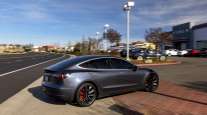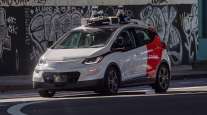Senior Reporter
Peloton to Develop System for Driverless Following Truck in Platooning

[Stay on top of transportation news: Get TTNews in your inbox.]
Peloton Technology Inc. announced it is expanding its vision for truck platooning and driver productivity.
The Mountain View, Calif.-based company is developing Automated Following, a system that relies on vehicle-to-vehicle communication to connect a driverless, fully automated following truck with a driver-controlled lead truck in a platoon.
The lead truck, driven by a human, would use the V2V wireless signal to control the steering, acceleration and radar-based braking of the following truck — with SAE Level 4 capabilities for highly autonomous driving — and connect the safety systems between the trucks with minimal latency, according to Peloton.
“We are testing it today. We are not announcing a product date for Automated Following,” Peloton Technology CEO Josh Switkes told Transport Topics. “We are going to put the same focus on safety with Automated Following as we have with Platoon Pro, and we won’t be rolling it out until we have gotten to that same level of safety.”
The company made the announcement July 17 at the Automated Vehicle Symposium 2019 in Orlando, Fla.
Peloton Automated Following by Transport Topics on Scribd
In Peloton’s existing Platoon Pro (a SAE Level 1 system), the driver in the following truck steers and monitors the situation, but the system controls the powertrain and brakes to manage the following distance precisely and to provide immediate reaction to whatever acceleration or braking the lead truck performs.
Six customers now operate Platoon Pro, and additional customer fleet trials are underway, Peloton reported, but did not identify the fleets.
“We have seen how challenging it is to get to the right level of safety even for a Level 1 system,” Switkes said. “And the reason is, you have this wide variety of hazards you can have out on the road. In the case of Level 4 for a single vehicle, you have this extraordinarily long distance ahead of you that you need to be reliably sensing and perceiving and reacting to. A heavy-duty truck in wet conditions can take many, many hundreds of feet to stop.”
In addition, he said a Level 4 stand-alone system must be able to detect with great accuracy if something ahead is, for instance, a trash bag floating in the air or a stopped vehicle.
Switkes said for Peloton’s prototype Level 4 system, those challenges get dramatically simplified when it is following another truck driven by a trained, skilled truck driver.”
The Level 4 system in the following truck just has to worry about how to follow the path of the truck in front, how not to hit the truck in front and how to avoid any obstacles that come between the trucks, he said.
“We think the other companies out there [developing and testing self-driving trucks] are starting to realize the challenges they face,” Switkes said. “With Level 4 Automated Following, we can much more rapidly tackle those challenges and deploy in a broader set of operating conditions, more roads and traffic and weather conditions, etc.”




